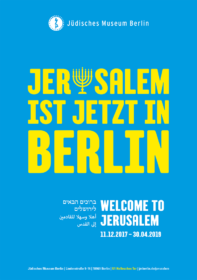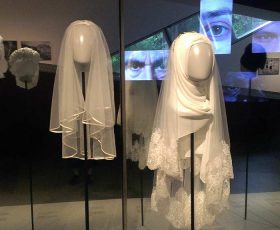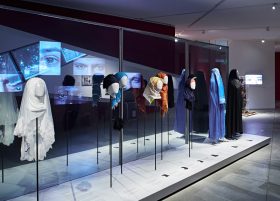How school children react to the tour through the exhibition Welcome to Jerusalem. A conversation with Marc Wrasse

Campaign for the exhibition Welcome to Jerusalem; Jewish Museum Berlin, designed by: Preuss und Preuss GmbH
You’ve worked for the Jewish Museum Berlin for many years, as well as for other museums. What makes this exhibition special?
The Jewish Museum Berlin has a wide variety of visitors—the audience here is nearly as diverse as the modern world itself. If you visit the museum or work here, you can have a lot of different experiences, including in experimental exhibitions such as Obedience (more information about the exhibition on our website). Due to their social and political significance, I always find encounters during tours through Welcome to Jerusalem (more on our website) to be something special. Muslim students in particular—and that label encompasses much variety, ranging from the third-generation Turkish people in Germany to Syrian war refugees with their anti-Israeli background—are highly attentive in this exhibition.
Why is that, in your opinion?
→ continue reading
The Italian Writer Elena Loewenthal Reflects on Strong Jewish Women in the Torah
The current exhibition Cherchez la Femme, which explores religious dress codes for women from women’s perspectives, remains on display until 27 August (more about the exhibition on our website). When I first found out the exhibition’s theme, I immediately thought of the novel Attese (2004) by the Italian author Elena Loewenthal. (The title means either “expectations” or “times of waiting.”) In four extended sections, the novel tells the stories of different Jewish female characters throughout the ages. But the novel’s real main character is a mysterious veil that follows the protagonists from Biblical times to modern-day Venice.

Veils in the exhibition Cherchez la femme; Jewish Museum Berlin, photo: Mirjam Bitter
We can read the veil as a metaphorical vessel of Jewish memory that women have guarded and passed on, a vessel that embodies recollection and forgetting, tradition and renewal. Indeed, the reasons each woman in the novel dons the veil are not only cultural (such as marking mourning) but personal: each of them reshapes it, sews in her own threads, or at least cultivates an idiosyncratic relationship with the garment she inherited. → continue reading
Our visitors on Cherchez la femme
For over three months, the exhibition Cherchez la femme has allowed visitors to explore the topic of women’s head coverings in three of the world’s major religions. Among other things, the exhibition demonstrates that the borders of (religious) clothing rules are constantly being redrawn and reinterpreted.
Since we’re very interested in the opinions of our visitors, we asked around about what people thought at the exhibition:
Christian (39), Ludwigsburg, pastor, teaches German and history
Which object did you like the best?

Different kinds of head coverings; Jewish Museum Berlin, photo: Yves Sucksdorff
The gallery with the different kinds of head coverings. I was impressed by the attention to detail. For example, I didn’t know how many differences
there were between headscarves, between Turkish and Arab styles.
What significance does your own hair have to you?
It’s important to me that I look good. I go to the barber regularly.
Would you say that you follow any clothing rules? → continue reading


